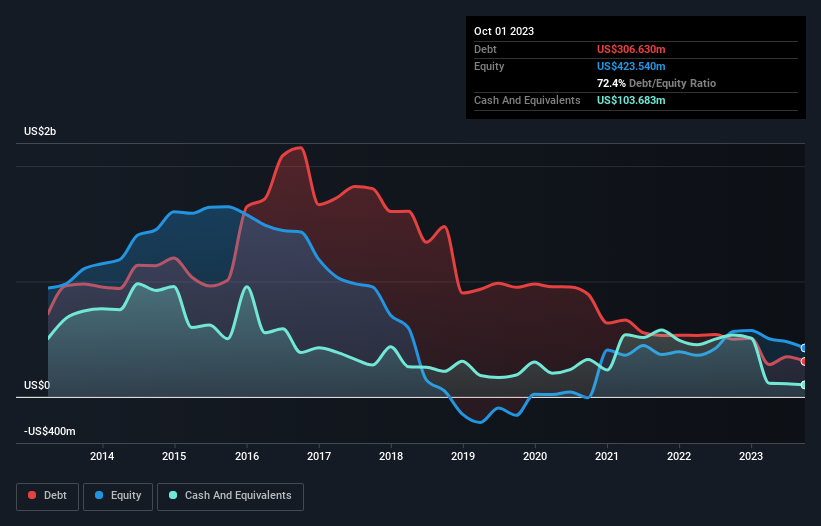
Warren Buffett famously said, 'Volatility is far from synonymous with risk.' When we think about how risky a company is, we always like to look at its use of debt, since debt overload can lead to ruin. As with many other companies SunPower Corporation (NASDAQ:SPWR) makes use of debt. But the real question is whether this debt is making the company risky.
When Is Debt A Problem?
Generally speaking, debt only becomes a real problem when a company can't easily pay it off, either by raising capital or with its own cash flow. If things get really bad, the lenders can take control of the business. However, a more usual (but still expensive) situation is where a company must dilute shareholders at a cheap share price simply to get debt under control. Of course, the upside of debt is that it often represents cheap capital, especially when it replaces dilution in a company with the ability to reinvest at high rates of return. The first thing to do when considering how much debt a business uses is to look at its cash and debt together.
Check out our latest analysis for SunPower
How Much Debt Does SunPower Carry?
As you can see below, SunPower had US$306.6m of debt at October 2023, down from US$499.4m a year prior. On the flip side, it has US$103.7m in cash leading to net debt of about US$202.9m.

A Look At SunPower's Liabilities
The latest balance sheet data shows that SunPower had liabilities of US$866.0m due within a year, and liabilities of US$157.8m falling due after that. On the other hand, it had cash of US$103.7m and US$248.3m worth of receivables due within a year. So it has liabilities totalling US$671.8m more than its cash and near-term receivables, combined.
This is a mountain of leverage relative to its market capitalization of US$729.5m. This suggests shareholders would be heavily diluted if the company needed to shore up its balance sheet in a hurry. When analysing debt levels, the balance sheet is the obvious place to start. But it is future earnings, more than anything, that will determine SunPower's ability to maintain a healthy balance sheet going forward. So if you want to see what the professionals think, you might find this free report on analyst profit forecasts to be interesting.
In the last year SunPower wasn't profitable at an EBIT level, but managed to grow its revenue by 15%, to US$1.8b. That rate of growth is a bit slow for our taste, but it takes all types to make a world.
Caveat Emptor
Importantly, SunPower had an earnings before interest and tax (EBIT) loss over the last year. To be specific the EBIT loss came in at US$56m. Considering that alongside the liabilities mentioned above does not give us much confidence that company should be using so much debt. So we think its balance sheet is a little strained, though not beyond repair. Another cause for caution is that is bled US$181m in negative free cash flow over the last twelve months. So suffice it to say we consider the stock very risky. When analysing debt levels, the balance sheet is the obvious place to start. But ultimately, every company can contain risks that exist outside of the balance sheet. We've identified 1 warning sign with SunPower , and understanding them should be part of your investment process.
When all is said and done, sometimes its easier to focus on companies that don't even need debt. Readers can access a list of growth stocks with zero net debt 100% free, right now.
New: Manage All Your Stock Portfolios in One Place
We've created the ultimate portfolio companion for stock investors, and it's free.
• Connect an unlimited number of Portfolios and see your total in one currency
• Be alerted to new Warning Signs or Risks via email or mobile
• Track the Fair Value of your stocks
Have feedback on this article? Concerned about the content? Get in touch with us directly. Alternatively, email editorial-team (at) simplywallst.com.
This article by Simply Wall St is general in nature. We provide commentary based on historical data and analyst forecasts only using an unbiased methodology and our articles are not intended to be financial advice. It does not constitute a recommendation to buy or sell any stock, and does not take account of your objectives, or your financial situation. We aim to bring you long-term focused analysis driven by fundamental data. Note that our analysis may not factor in the latest price-sensitive company announcements or qualitative material. Simply Wall St has no position in any stocks mentioned.
About OTCPK:SPWR.Q
SunPower
SunPower Corporation, fournisseur de technologie solaire et de services énergétiques, propose des solutions solaires, de stockage et d'énergie domestique principalement aux États-Unis et au Canada.
Moderate and slightly overvalued.
Similar Companies
Market Insights
Community Narratives




